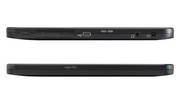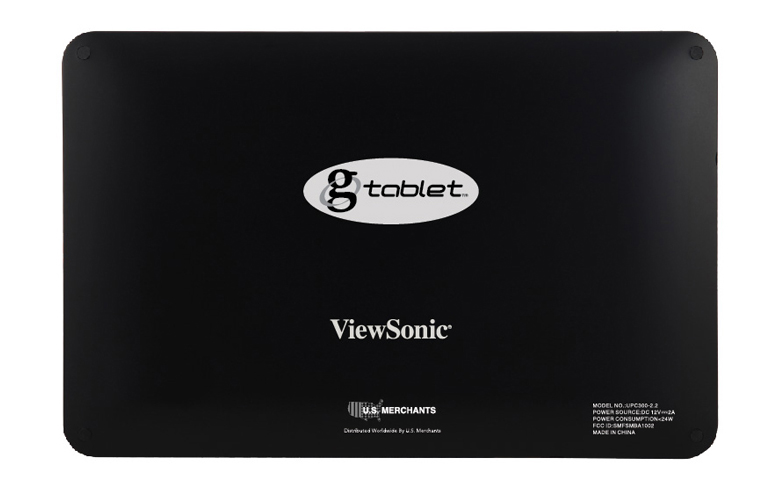Viewsonic gTablet
Ausstattung / Datenblatt

Preisvergleich
Durchschnitt von 2 Bewertungen (aus 2 Tests)
Testberichte für das Viewsonic gTablet
Quelle: Justech'n
 EN→DE Archive.org version
EN→DE Archive.org versionI am much happier with the G Tablet now that I have the new ROM. It does not fix the bad viewing angles with the screen, but it helps make it more bearable. The VEGAn crew are also working on a new version of the ROM that is rebased on the Gingerbread (2.3.3) version of Android. I am very excited about this because it will allow the tablet to stay relevant for a while longer.
Einzeltest, online verfügbar, Sehr kurz, Datum: 18.03.2011
Bewertung: Gesamt: 94% Preis: 100% Leistung: 100% Ausstattung: 90% Ergonomie: 90%
Quelle: Justech'n
 EN→DE Archive.org version
EN→DE Archive.org versionSo I really have mixed feelings about this tablet. As it stands I think there are more negatives than positives, but there is always the prospect of rooting the G Tablet and loading on a custom ROM, however that is beyond the scope of this review. So sticking just with the stock features and performance I have to recommend that you shy away from this Tablet. Even though it has a reasonable $399 price tag it is too limited to recommend. If the screen didn’t have such bad viewing angles, flash worked, and it had better performance then this would be a different story. I have a hard time recommending something that is difficult to use, and difficult to see.
Einzeltest, online verfügbar, Sehr kurz, Datum: 21.02.2011
Bewertung: Gesamt: 75% Preis: 80% Leistung: 80% Ausstattung: 80% Ergonomie: 80%
Kommentar
NVIDIA GeForce ULP (Tegra 2): Integrierte Ultra Low Power (ULP) GPU im Tegra 2 SoC und je nach version von 300 bis 400 MHz getaktet.
3D Spiele sind auf diesen Vertretern nur in Ausnahmen spielbar, grundsätzlich sind die Grafiklösungen hierfür jedoch nicht geeignet. Office Programme und Internet surfen dürfte jedoch ohne Problem möglich sein.
» Weitere Informationen gibt es in unserem Notebook-Grafikkartenvergleich und der Benchmarkliste.
2 (250): Cortex A9 basierter Dual-Core SoC (System on a Chip) mit integrierter GeForce Grafikkarte und DDR2 Speicherkontroller.» Weitere Infos gibt es in unserem Prozessorvergleich Vergleich mobiler Prozessoren und der Prozessoren Benchmarkliste .
10.10": Dies ist ein Standardanzeigeformat für Tablet-Computer oder kleine Convertibles. Man sieht mehr auf diesem Bildschirm als auf einem kleinen Smartphone. Große Auflösungen darf man aber nicht erwarten. Auf der anderen Seite ist die Mobilität kein Problem.» Prüfen Sie in unserer DPI Liste, welche Displays wie fein aufgelöst sind.
0.7 kg:
In diesem Gewichtsbereich liegen ein paar schwere Smartphones und vor allem Tablets.
Viewsonic: Bekannt ist die 1987 (unter dem Namen Keypoint Technology Corporation) gegründete taiwanesisch-amerikanische ViewSonic Corporation (1993 umbenannt) vor allem für Displays/Monitore und Projektoren, visuelle Anzeigegeräte, einschließlich Flüssigkristallbildschirme, interaktive Whiteboards, sowie auf Software für digitale Whiteboards.
84.5%: Diese Bewertung ist leicht überdurchschnittlich, es gibt etwas mehr Geräte mit schlechteren Beurteilungen. Klare Kaufempfehlungen sehen aber anders aus.
» Lesen Sie auch unsere Notebook-Kaufberatung.


 Deutsch
Deutsch English
English Español
Español Français
Français Italiano
Italiano Nederlands
Nederlands Polski
Polski Português
Português Русский
Русский Türkçe
Türkçe Svenska
Svenska Chinese
Chinese Magyar
Magyar
